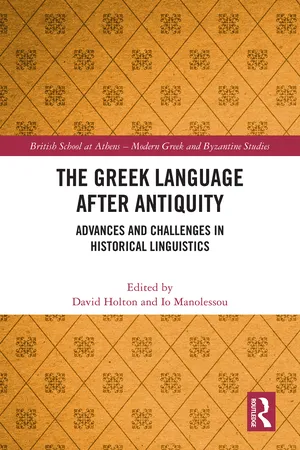
The Greek Language after Antiquity
Advances and Challenges in Historical Linguistics
- 256 pages
- English
- ePUB (mobile friendly)
- Available on iOS & Android
The Greek Language after Antiquity
Advances and Challenges in Historical Linguistics
About this book
The Greek Language after Antiquity offers an in-depth look at the diachrony of the Greek language, focusing on a period relatively neglected by modern scholarship: the more than 1, 000 years between the end of Antiquity and the early modern period. These studies, written by experts in the field, target different levels of analysis (phonology, morphology, semantics, lexicon, dialectology, sociolinguistics), combining substantial primary data with various theoretical approaches.
It begins with a radical proposal for a different approach to the historical linguistics of Greek, focused on the process of language diversification, as opposed to the traditional genetic approach to dialect emergence. Other topics include register variation in Byzantine literature, crucial for understanding the subsequent evolution of a written standard; morphological variation in conjunction with problems of textual transmission in medieval and early modern vernacular texts, with special focus on the notion of "philology"; evidence for language contact in the Late Medieval period; and the use of graphemic evidence, i.e. spelling, to detect changes in pronunciation over a long time span. Two chapters examine issues of word formation: one presents a new research project on diachronic derivational morphology; the other examines compound formation in the Cretan dialect. The final chapter examines theoretical and methodological issues in studying the historical semantics of Greek.
This book is essential reading for researchers in Greek historical linguistics and especially useful for students, teachers and researchers in Classics, Byzantine studies and general linguistics, with important connections to the historical linguistics and text-critical studies of other languages, particularly Romance and Turkish.
Frequently asked questions
- Essential is ideal for learners and professionals who enjoy exploring a wide range of subjects. Access the Essential Library with 800,000+ trusted titles and best-sellers across business, personal growth, and the humanities. Includes unlimited reading time and Standard Read Aloud voice.
- Complete: Perfect for advanced learners and researchers needing full, unrestricted access. Unlock 1.4M+ books across hundreds of subjects, including academic and specialized titles. The Complete Plan also includes advanced features like Premium Read Aloud and Research Assistant.
Please note we cannot support devices running on iOS 13 and Android 7 or earlier. Learn more about using the app.
Information
Table of contents
- Cover
- Half-Title Page
- Series Page
- Title Page
- Copyright Page
- Table of Contents
- Notes on contributors
- List of abbreviations
- Primary sources
- Introduction
- 1 The regional diversification of Greek ad
- 2 Investigating the diachronic phonology of Medieval and Modern Greek through graphemic evidence
- 3 Language contact in Late Medieval Greek: An under-estimated phenomenon?
- 4 Philology and φιλολογία: Linguistic variation in Medieval and Early Modern Greek from the viewpoint of textual scholarship
- 5 Many linguistic ways to tell the same story: The four versions of the Life of Maximos the Hutburner*
- 6 Medieval and Early Modern Greek derivational morphology: The missing chapters
- 7 Compounding in Cretan across centuries
- 8 Issues in the historical semantic analysis of Modern Greek
- Index